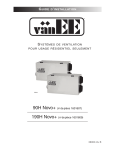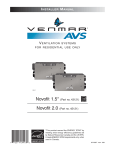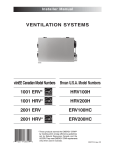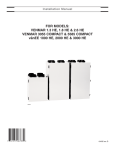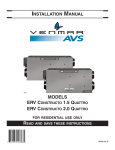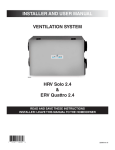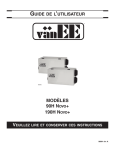Download vanEE 90 H Installation manual
Transcript
I NSTALLER M ANUAL ® V ENTILATION SYSTEMS FOR RESIDENTIAL USE ONLY VB0106 90H Novo+ 190H Novo+ (Part No. 1601607) (Part No. 1601609) 08003 rev. B About this Manual This manual uses the following symbols to emphasize particular information: ! WARNING Identifies an instruction which, if not followed, might cause serious personal injuries including possibility of death. CAUTION Denotes an instruction which, if not followed, may severely damage the unit and/or its components. NOTE: Indicates supplementary information needed to fully complete an instruction. ! WARNING When performing installation, servicing or cleaning the unit, it is recommended to wear safety glasses and gloves. CAUTION This unit is intended for residential use only. NOTE: This installation manual refers to Novoclimat™ requirements. The specifications are subject to change without notice. For more details, refer to Novoclimat program. Novoclimat is a performing dwelling concept created by the Agence de l’efficacité énergétique of Québec, to insure comfort, healt and savings for the occupants. Many requirements, mainly for the building enveloppe, tightness and ventilation must be met for a house to be Novoclimat certified, and vänEE has conceived a unit with all the HRV features required by this concept. Please note that Novoclimat also has specific requirements regarding the system and ducts installation and balancing. 2 Table of Contents 1. SERVICE ..........................................................................................4-5 1.1 3-D Drawing ................................................................................4 1.2 Parts Ordering Chart....................................................................5 1.3 Technical Support ........................................................................5 2. 3. SIZING ................................................................................................5 TECHNICAL DATA ................................................................................6 3.1 3.2 3.3 3.4 3.5 4. Air Distribution..............................................................................6 Defrost Cycles..............................................................................6 Dimensions ..................................................................................6 Specifications ..............................................................................6 Performance Charts ....................................................................7 TYPICAL INSTALLATIONS ....................................................................8 4.1 Fully Ducted System ....................................................................8 4.2 System Combined with a Furnace ..............................................8 5. INSTALLATION ................................................................................9-14 5.1 Locating and Mounting the Unit ..................................................9 5.2 Planning the Ductwork ................................................................9 5.3 Calculating the Duct Size ..........................................................10 5.3.1 Example of Calculation ....................................................10 5.3.2 Registers Location and Airflows Distribution ..................10 5.4 Installing the Ductwork and Registers ......................................11 5.4.1 Fully Ducted System ........................................................11 5.4.2 System Combined with a Furnace ..................................11 5.5 Connecting the Ducts to the Unit ..............................................12 5.6 Installing the Exterior Hoods ......................................................13 5.7 Connecting the Drain ................................................................14 6. MAXIMUM MAIN CONTROL ........................................................15-16 6.1 Dimensions and Specifications ................................................15 6.2 Main Control Installation ....................................................15-16 6.3 Electrical Connection to the Furnace ......................................16 7. 8. 9. WIRING DIAGRAM ............................................................................17 AIR FLOW BALANCING ....................................................................18 OVERALL VERIFICATION ..............................................................19-20 9.1 9.2 10. 11. 12. Main Control ............................................................................19 Auxiliary Controls ....................................................................20 MAINTENANCE/INSTRUCTIONS FOR USER ......................................20 TROUBLESHOOTING ....................................................................21-22 REFERENCES....................................................................................22 3 4 VL0029 3 2 1 18 4 6 5 16 7 8 15 14 3 10 13 8 11 9 12 1.1 17 13 1. Service 3-D DRAWING 1. 1.2 Service (cont’d) PARTS ORDERING CHART No. 1 2 3 4 5 Double Collar Port #2 Damper #1 (kit) Damper Rod (kit) Electronic Board & Spacers (kit) Thermistor (kit) 6 Door Latches & Screws 7 8 9 10 11 12 Damper Actuator Assembly Filter Blower Assembly Square Damper (kit) Door Ass’y (including 12 & 13) Door Latches (keeper) & Screws Hinge Ass’y (kit) Heat Recovery Core Balancing Double Collar Port Balancing Damper Drain Connector (kit) Door Switch (SPST), E69 10A 13 14 15 16 17 18 90H NOVO+ 1601607 02257 12454 13037 13038 12895 00886 (2) 00601 (4) 13734 03308 12908 13033 17206 00887 (2) 00601 (4) 13036 03322 02256 02253 03203 01825 Description 190H NOVO+ 1601609 02257 12454 13037 13038 12895 00886 (2) 00601 (4) 13734 03308 12912 13033 17206 00887 (2) 00601 (4) 13036 03322 02256 02253 03203 01825 Please note that parts not listed are not available; those parts require assembly knowledge that only manufacturer can guarantee. TO ORDER PARTS: Contact your local distributor. 1.3 TECHNICAL SUPPORT (FOR ASSISTANCE) For assistance, call on weekdays, from 8:30 a.m. to 5:00 p.m. (Eastern Standard Time). NOTE: Do not call this number for ordering parts. This phone number is for the installers only. 1-888-908-2633 (toll-free) 2. Sizing On high speed, the 90H Novo+ units produce about 150 cfm, and 190H Novo+ units produce about 189 cfm. According to the Novoclimat Ventilation needs vs. the number of rooms chart, the 90H Novo+ units can be installed in house having up to 13 rooms*, and 190H Novo+ units can be installed in house having up to 16 rooms*. *Houses with a non finished section having an area less than 2/3 of the house, or without basement. Refer to Novoclimat requirements for more details. 5 3. Technical Data 3.1 AIR DISTRIBUTION NORMAL OPERATION STALE AIR TO OUTSIDE FRESH AIR TO BUILDING DEFROST AND/OR FILTRATION MODE FILTERED AIR TO BUILDING VF0016 FRESH AIR FROM OUTSIDE STALE AIR FROM BUILDING STALE AIR FROM BUILDING VF0018 3.2 DEFROST CYCLES Outside Temperature Celcius (°C) Fahrenheit (°F) Defrost Cycles Defrosting (min.) Operation time (min.) Extended Defrost Cycles Defrosting (min.) between each defrost cycle -5 -15 -27 IN 23 5 -17 A COLD REGION, SET UP 3.3 60 32 20 6 6 6 EXTENDED DEFROST BY REMOVING JUMPER Operation time (min.) between each defrost cycle 10 10 10 JU1F 30 20 15 OFF THE CIRCUIT BOARD. DIMENSIONS 6" (152 mm) 30 1/4" (768 mm) 17 1/8" (435 mm) 16 1/2" (419 mm) VK0029A 3.4 SPECIFICATIONS Model Weight Port Diameter Drain Diameter Installation Motor Speed Electrical Supply Power Consumption 90H Novo+ 190H Novo+ 65 lb (29.5 kg) 67 lb (30.5 kg) 6” (152 mm) 6” (152 mm) ½” (12 mm) ½” (12 mm) Chains, springs and hooks (provided with the unit) High and low speed factory set (optional increased or decreased low speed) 120 V, 60 Hz 120 V, 60 Hz 150 W 240 W 6 3. 3.5 Technical Data (cont’d) PERFORMANCE CHARTS 90H NOVO+ ELECTRICAL REQUIREMENTS: 120 VOLTS, 1.3 EXHAUST AIR TRANSFER RATIO: 0.01 AMPS. EXT STATIC PRESSURE Pa in.w.g. 25 .1 50 .2 75 .3 100 .4 125 .5 150 .6 175 .7 200 .8 NET SUPPLY AIR FLOW l/s cfm m3/h 83 175 299 79 168 284 75 159 270 71 150 256 64 136 230 59 126 216 53 113 191 43 91 155 l/s 83 80 75 71 64 60 53 43 GROSS AIR FLOW SUPPLY EXHAUST cfm m3/h l/s cfm m3/h 176 299 83 175 295 169 288 78 165 281 159 270 75 158 270 151 256 69 146 248 136 230 60 127 216 127 216 49 103 273 113 191 38 80 227 91 155 21 45 76 Energy Performance SUPPLY TEMPERATURE C° F° HEATING 0 +32 0 +32 0 +32 -25 -13 -25 -13 l/s cfm 31 56 –– 37 –– 66 119 –– 78 –– 112 202 –– 133 –– 85 124 –– 114 –– +95 +95 –– –– –– –– –– –– –– –– Supply (l/s) Exhaust (l/s) 200 175 150 125 100 75 50 25 0 0 25 50 75 100 125 150 Gross Air Flow: l/s (0.47 l/s = 1 cfm) (m 3/h = l/s x 3.6) 3 COOLING +35 +35 225 VG0010 POWER SENSIBLE APPARENT LATENT RECOVERY/ CONSUMED RECOVERY SENSIBLE MOISTURE m /h WATTS EFFICIENCY EFFECTIVENESS TRANSFER NET AIR FLOW EXTERNAL STATIC PRESSUREPASCALS (248.8 pascals = 1” of water) Ventilation Performance 69 60 –– 62 –– 81 70 –– 80 –– -0.01 -0.01 –– 0.08 –– TOTAL RECOVERY EFFICIENCY Not tested –– NOTE: All specifications are subjected to change without notice. 190H NOVO+ ELECTRICAL REQUIREMENTS: 120 VOLTS, 2.1 EXHAUST AIR TRANSFER RATIO: 0.01 AMPS. EXT STATIC PRESSURE Pa in.w.g. 25 .1 50 .2 75 .3 100 .4 125 .5 150 .6 175 .7 NET SUPPLY GROSS AIR FLOW AIR FLOW SUPPLY EXHAUST l/s cfm m3/h l/s cfm m3/h l/s cfm m3/h 110 234 396 112 237 403 112 237 403 103 219 374 105 223 378 106 225 382 98 208 353 100 211 360 99 210 356 89 189 320 91 192 328 91 193 328 84 177 302 85 180 306 82 174 295 71 151 256 72 153 259 71 149 256 94 158 64 136 230 65 138 234 44 Energy Performance SUPPLY TEMPERATURE C° F° HEATING 0 +32 0 +32 0 +32 -25 -13 -25 -13 POWER SENSIBLE APPARENT LATENT RECOVERY/ NET AIR FLOW 3 CONSUMED RECOVERY SENSIBLE MOISTURE l/s cfm m /h WATTS EFFICIENCY EFFECTIVENESS TRANSFER 56 86 –– 37 –– 119 182 –– 78 –– 202 210 –– 133 –– 124 197 –– 114 –– –– –– –– –– –– –– –– –– COOLING +35 +35 +95 +95 60 53 –– 62 –– 70 62 –– 80 –– EXTERNAL STATIC PRESSUREPASCALS (248.8 pascals = 1” of water) Ventilation Performance 225 Supply (l/s) Exhaust (l/s) 200 175 150 125 100 75 50 25 VG0011 0 0 25 50 75 100 125 Gross Air Flow: l/s (0.47 l/s = 1 cfm) (m 3/h = l/s x 3.6) -0.01 -0.01 –– 0.08 –– TOTAL RECOVERY EFFICIENCY Not tested –– 7 NOTE: All specifications are subjected to change without notice. 150 4. Typical Installations There are three (2) common installation methods. 4.1 FULLY DUCTED SYSTEM (Primarily for homes with radiant hot water or electric baseboard heating. See Figure 1.) The complete ductwork of the ventilation system consists in ducts for the fresh air distribution and other ducts dedicated to exhaust moist, stale air to the outside. Fresh air is supplied to bedrooms and principal living areas (at least one register per level). Moist, stale air is exhausted to the outside from the high humidity areas in the home, such as bathrooms. Use an independant bathroom fan in washroom (without a bath tub nor a shower) and a range hood in kitchen to exhaust stale air. Homes with more than one level require at least one exhaust register at the highest level. 4.2 SYSTEM COMBINED WITH A See 5.4.1 for details VH0062 Figure 1 FURNACE (For homes with forced air heating. See Figure 2.) Moist, stale air is exhausted from the high humidity areas in the home, such as bathrooms, kitchen and laundry room. Fresh air is supplied to the cold air return or the supply duct of the furnace. Use an independant bathroom fan in washroom (without a bath tub nor a shower) and a range hood in kitchen to exhaust stale air. Homes with more than one level require at least one exhaust register at the highest level. NOTE: For this type of installation, it is essential that the furnace blower runs when the unit is in operation. See 5.4.2 for details VH0063 Figure 2 8 5. Installation INSPECTING THE BOX CONTENT • • • • Inspect the exterior of the unit for shipping damage. Ensure that there is no damage to the door, door latches, door hinges, dampers, duct collars, cabinet, etc. Inspect the interior of the unit for damage. Ensure that the fan motor assembly, heat recovery core, insulation, dampers, damper actuator and condensation tray are all intact. If the unit was damaged during shipping, contact your local distributor. (Claims must be made within 24 hours after delivery.) Use checklist included with the unit to ensure that no parts are missing. 5.1 LOCATING AND MOUNTING THE UNIT Choose an appropriate location for the unit: • Within an area of the house where the temperature is above 10°C/50°F (basement, furnace room, laundry room, etc.). • Away from living areas (dining room, living room, bedroom), if possible. • So as to provide easy access to the interior cabinet and to the control panel on the side of the unit. • Close to an exterior wall, so as to limit the length of the insulated flexible duct to and from the unit. • Close to a drain. VD0037 • Away from hot chimneys, electrical panel and other fire hazards. Figure 4 • Allow for a power source (standard outlet). Hang the unit with the 4 chains and springs provided (see Figures 4 and 5). VD0038 Figure 5 1/8" (3 mm) CAUTION Make sure the unit is level, with a 1/8’’ (3 mm) tilt backwards (see Figure 6). VD0039A Figure 6 5.2 PLANNING THE DUCTWORK a) Follow the instructions in Section 5.3 on next page to determine the appropriate duct diameters for your system. b) Keep it simple. Plan for a minimum number of bends and joints. Keep the length of insulated duct to a minimum. c) Do not use wall cavities as ducts. Do not use branch lines smaller than 4” (102 mm) Ø. d) Do not ventilate crawl spaces or cold rooms. Do not attempt to recover the exhaust air from a dryer or a range hood. This would cause clogging of the recovery module. Use rigid ducts for fresh air distribution and stale air exhaust (“warm” side of HRV) and sheet metal for the kitchen exhaust duct (if need be). e) Be sure to plan for at least one exhaust register on the highest lived-in level of the house if it has 2 floors or more. 9 5. 5.3 Installation (cont’d) CALCULATING THE DUCT SIZE Use the table below to ensure that the ducts you intend to install will be carrying air flows at/or under the maximum air flow values. Never install a duct if its air flow exceeds the maximum value. NOVOCLIMAT CHART FOR SIZE OF DUCT CONNECTED TO REGISTER VS. AIR FLOW ROUND DUCT 4" 5" 6" RECTANGULAR DUCT 2¼" OR 3¼” X 10" 2¼" OR 3¼” X 10" 3¼” OR 4" X 10" MAXIMUM AIR FLOW 40 CFM 65 CFM 110 CFM end branches 5”ø 55 cfm main branch 6”ø 110 cfm VI0003 5.3.1 Calculation Example: figure 7 Problem: My installation requires two exhaust registers (both for the bathrooms). I will connect these registers to a main duct which will connect to the unit (high speed performance value of 110 cfm). What size of duct should I use for the main exhaust duct and for the two end branches leading to the registers? (See Figure 7.) Solution: Main duct: Table above indicates a 6” Ø duct: maximum air flow: 110 cfm. The high speed air flow of 110 cfm equals the maximum value (110). Therefore a 6” Ø duct or larger is an appropriate choice for the main exhaust duct. End branches: Each end branch will have to transport an air flow of 55 cfm (110 divided by 2). Table above indicates a 5” Ø duct: maximum air flow: 65 cfm. The high speed air flow of 55 cfm is far enough away from the maximum value (65). Therefore a 5” Ø duct or larger is an appropriate choice for the 2 end branches. NOTE: A 4” Ø duct would have been too small because the maximum acceptable value for a 4” Ø duct is 40 cfm. 5.3.2 Registers Location and Air Flows Distribution: The registers location and the air flow distribution must be taken in account when performing ductwork installation. Refer to the Novoclimat table below to plan the registers location. REGISTER LOCATION KITCHEN DINING ROOM LIVING ROOM OFFICE RECREATION ROOM MASTER BEDROOM SECONDARY BEDROOM(S) MAIN BATHROOM SECONDARY BATHROOM(S) LAUNDRY ROOM WORKSHOP NON-FINISHED BASEMENT FRESH AIR FLOWS MINIMUM MAXIMUM REQUIRED ACCEPTABLE 4,7 L/S (10 PCM) 11,8 L/S (25 PCM) 4,7 L/S (10 PCM) 18,9 L/S (40 PCM) 4,7 L/S (10 PCM) 9,4 L/S (20 PCM) 4,7 L/S (10 PCM) 18,9 L/S (40 PCM) 9,4 L/S (20 PCM) 9,4 L/S (20 PCM) 4,7 L/S (10 PCM) 9,4 L/S (20 PCM) 4,7 L/S (10 PCM) 18,9 L/S (40 PCM) 10 EXHAUST AIR FLOWS MINIMUM MAXIMUM REQUIRED ACCEPTABLE 0 23,6 L/S (50 PCM) 23,6 L/S (50 PCM) 51,9 L/S (110 PCM) 14,2 L/S (30 PCM) 51,9 L/S (110 PCM) 0 0 23,6 L/S (50 PCM) 5 5.4 Installation (cont’d) INSTALLING THE DUCTWORK 0 ! AND REGISTERS WARNING Never install a stale air exhaust register in a room where there is a combustion device, such as a gas furnace, a gas water heater or a fireplace. 5.4.1 Fully Ducted System (as illustrated in Section 4.1) Stale air exhaust ductwork: • • • • Install registers in areas where contaminants are produced: bathrooms, laundry room, etc. Install registers 6 to 12 inches (152 to 305 mm) from the ceiling on an interior wall OR install them in the ceiling (the duct leading to the register must never go through the attic). If a register is installed in the kitchen, it must have a washable filter and be located at least 4 feet (1.2 m) from the range. If possible, measure the velocity of the air flowing through the registers. If the velocity is higher than 400 ft/min. (122 m/min), then the register type is too small. Replace with a larger one. Fresh air distribution ductwork: • • Install registers in every bedrooms, in living room and a minimum of one per level without bedroom nor living room. Install registers high on the walls with air flow directed towards the ceiling. The horizontal draft must be perceptible at 3 ft. (910 mm) from register. (The cooler air will then cross the upper part of the room and mix with room air before descending to occupant level.) 5.4.2 System Combined with a Furnace (as illustrated in Section 4.2) Stale air exhaust ductwork: (same as for Fully Ducted System, described on point 5.4.1) Fresh air distribution: ! WARNING When performing duct connection to the furnace, installation must be done in accordance with all applicable codes and standards. Please refer to your local building code. • Cut an opening into the furnace return duct not less than 10 feet (3.1 m) from the furnace (A+B). • Connect this opening to one end of the top section of a metal T coupling (the T will be reversed, see shaded part in Figure 8). • Connect the other end of the T coupling top section to the fresh air distribution port of the HRV (see Figure 8). NOTE: For this case, it is essential that the furnace blower runs when the unit is in operation. Synchronize the furnace blower operation with the HRV operation (see Section 6.3). 11 A B VJ0051 A+B = not less than 10’ (3.1 m) Figure 8 5. 5.5 Installation (cont’d) CONNECTING THE DUCTS TO THE UNIT Insulated flexible duct Use the following procedure for connecting the insulated flexible duct to the ports on the unit (exhaust to outside and fresh air from outside). a) Pull back the insulation to expose the flexible duct. b) Connect the interior flexible duct to the port using a duct tie. c) Carefully seal the connection with duct tape. d) Pull the insulation over the joint and tuck it between the inner and outer rings of the double collar. e) Pull the vapor barrier over the insulation and over the outer ring of the double collar. f) Apply duct tape to the joint making an airtight seal. Avoid compressing the insulation when you pull the tape tightly around the joint. Compressed insulation loses its R value and causes water dripping due to condensation on the exterior surface of the duct. CAUTION Make sure that the vapor barrier on the insulated ducts does not tear during installation to avoid condensation within the duct. a) VJ0001 b) c) d), e) VJ0002 VJ0003 VJ0004 f) VJ0005 Rigid ducts Use duct tape to connect the rigid ducts to the ports. CAUTION Do not use screws to connect rigid ducts to the ports. Make sure that the 2 balancing dampers are left in a fully open position before connecting the ducts to these ports (fresh air distribution port and stale air exhaust port as shown on Figure 9). VJ0007 Figure 9 12 5. 5.6 Installation (cont’d) INSTALLING THE EXTERIOR HOODS Choose an appropriate location for installing the exterior hoods: • a minimum distance of 6 feet (1.8 m) between the hoods to avoid cross-contamination • a minimum distance of 18 inches (457 mm) from the ground Make sure the intake hood is at least 6 feet (1.8 m) away from any of the following: • dryer exhaust, high efficiency furnace vent, central vacuum vent • gas meter exhaust, gas barbecue-grill • any exhaust from a combustion source • garbage bin and any other source of contamination Refer to Figure 10 for connecting the insulated duct to the hoods. Place the “FRESH AIR INTAKE” sticker, provided in the installation kit, on corresponding hood. An “Anti-Gust Intake Hood” should be installed in regions where a lot of snow is expected to fall. 6”Ø (152 mm) Exhaust hood Intake hood 18” (457 mm) 6’ (1.8 m) 18” (457 mm) 6’ (1.8 m) Optional duct location Tape and duct tie VD0028 Figure 10 13 18” (457 mm) 5. Installation 5.7 CONNECTING THE DRAIN (cont’d) Inside view 1 VO0010 VO0008 2 In order to keep the drain pan intact, hand tighten the 2 plastic drain fittings to the unit using the gaskets, washers and nuts as shown. To install the drain fittings, punch the 2 knock-out sections located at the bottom of the unit. 12" (305 mm) 3 VO0004A VO0005 Join the 2 short sections to the “T” junction and main tube as shown. Cut 2 sections of plastic tubing, about 12” (305 mm) long and attach them to each drain fitting. TIE-WRAP TO DRAIN VO0011 4 5 Make a water trap loop in the tube to prevent the unit from drawing unpleasant odors from the drain source. Make sure this loop is situated BELOW the “T” as shown. This will prevent water from being drawn back up into the unit in case of negative pressure. Run the tube to the floor drain or to an alternative drain pipe. Be sure there is a slight slope for the run-off. 14 6. 6.1 Maximum Main Control DIMENSIONS AND SPECIFICATIONS 1³/8" (35 mm) 5" (127 mm) Voltage: 12 volts DC Dimensions: 5” x 5” x 13⁄8” 5" (127 mm) (127 mm x 127 mm x 35 mm) VC0016A SIDE VIEW FRONT VIEW 6.2 MAIN CONTROL INSTALLATION CAUTION Never install more than one main control per unit. INSTRUCTIONS: 1- Determine the location of the control. The wall control must be installed in a central location on the main floor. Typical locations for these controls are main hallways and family room. 2- Remove the button and the cover plate of the control. VC0093 2" (5 cm) 3- Install the wall control 60 inches (1.5 m) from the floor and leave a free space of at least 2 inches (5 cm) to the right of the control to allow user to slide out the control instructions. Use the template provided in the control box to position the wire hole and the screw holes. Use the screws and the plastic anchors provided in the installation kit to secure the control. 60" (1.5 m) VD0025A Y 15 R GB VE0124 4- Connect the wires to the main control. 6. Maximum Main Control 6.2 MAIN CONTROL INSTALLATION (cont’d) (CONT’D) 5- Make sure the instruction pull-out is in the occupant’s language. If not, turn it to the other side. 6- Reinstall the cover plate and the button. VC0061 7- Connect the wires to their corresponding position inside the electrical compartment. Make sure the connections of the unit and of the wall control correspond exactly. 8- Connect the optional controls. F F I OCOL Y R G B VE0084 9- Do the appropriate connection to the furnace (if applicable) by referring to Section 6.3. 10- NOTE: If you are in a cold region, set up “extended defrost” by removing jumper JU1F on the main circuit board inside the electrical compartment (see Section 7). 11- Plug in the unit and do the “overall verification” of the system as described in Section 9. 6.3 ELECTRICAL CONNECTION TO THE FURNACE ! WARNING Never connect a 120-volt AC circuit to the terminals of the furnace interlock (standard wiring). Only use the low voltage class 2 circuit of the furnace blower control. For a furnace connected to cooling system: On some older thermostats, energizing the “R” and “G” terminals at the furnace has the effect of energizing “Y” at the thermostat and thereby turning on the cooling system. If you identify this type of thermostat, you must use the “alternate furnace interlock wiring”. An additional control relay will then have to be installed. Standard furnace interlock wiring W G Y THERMOSTAT TERMINALS W 4 WIRES UNIT CONTROL CONNECTOR J3 9 8 7 6 5 4 3 2 1 FOUR WIRES TWO WIRES heating only R Alternate furnace interlock wiring F F I OC OL Y R G B 2 WIRES (heating only) W W R RR G G R G Y wiring nuts C Y YY FURNACE 24-VOLT TERMINAL BLOCK FURNACE 24-VOLT TERMINAL BLOCK TWO WIRES COOLING SYSTEM VE0010A VE0009A 16 1 4 77 2 5 8 3 6 9 GRAY RED BROWN GREEN NC C Unit Control Module 9-PIN AMP PLUG J1 THERMOSTAT TERMINAL NO COM BLUE *FURNACE INTERLOCK RELAY 2 WIRES COOLING SYSTEM *FURNACE INTERLOCK RELAY, PART # 12658 17 VE0017A NOTES ELECTRONIC ASSEMBLY T1 W BK GY ABCDEFG BK O R 6- The furnace fan circuit must be class 2 circuit only. 5- The field wiring must comply with applicable codes, ordinnances and regulations. 4- Use the factory supplied protective tubing. 3- If any of the original wire, as supplied, must be replaced, use the same or equivalent wire. 2- The factory set wiring for blower speed selection is high and low. Medium speed can be selected instead of low speed. Disconnect the RED wire from the motor RED tap and connect it to the motor BLUE tap. NO BK BL BN G GY BK LOW VOLTAGE AND FIELD WIRE LINE VOLTAGE NEMA-15P 5-15 PLUG W1 COLOR CODE NC NO CONNECTION O ORANGE R RED W WHITE Y YELLOW LINE W G C1 120V 60 Hz BL BL G DAMPER MOTOR M2 MAIN EARTHING POINT G 3 2 1 X2 X1 NEUTRAL BL BL G BLACK BLUE BROWN GREEN GREY DOOR INTERLOCK SWITCH S1 COM BL BL 1 2 3 M1 GY NEUTRAL O HIGH G BN NC R LOW BN R BL MEDIUM (NOTE 2) FAN MOTOR GY O G FURNACE BLOWER NOTES 5, 6 OPTIONAL INTERLOCK OVERRIDE SWITCH NOTE 5 OVERRIDE SWITCH OPTIONAL OVERRIDE LED R BK Y NOTES 1, 5 WALL CONTROL WALL CONTROL WALL CONTROL WALL CONTROL 120V 60Hz Logic S1 JU 1 J3 1 K5 RELAY K2 RELAY J1 4 J1 6 J1 9 2 1 A B C D E F G IN IN OUT OUT OUT OUT IN IN OUT IN OUT OUT EXTENDED DEFROST STANDARD MODE NC MED M1 J1 8 J1 1 NEUTRAL J1 2 10/30 6/60 10/20 6/32 10/15 6/20 DEFROST/VENTILATION MINUTES 23°F 5°F -22°F -5°C -15°C -27°C DEFROST TIME DAMPER MOTOR M2 HIGH FAN MOTOR LOW FUNCTION TABLE RELAY MODE K1 K2 K4* K5 Intermittent 0 0 0 1 Exchange Low 1 0 1 0 Exchange High 1 1 1 0 Circulation Low 1 0 1 1 Circulation High 1 1 1 1 Defrost Cycle 1 1 1 1 Off 0 0 0 1 0 = Relay coil is de-energized 1 = Relay coil is energized * On special mode, K4 is cycling 10 min. ON and 20 min. OFF OUT OUT TYPE FURNACE BLOWER INTERLOCK CLASS 2 CIRCUIT ONLY J3 2 ELECTRONIC ASSEMBLY K1 RELAY K4 RELAY J1 3 A1 JU1A JU1B JU1C JU1D JU1E JU1F JU1G JUMPERS TABLE VE0018A FROM MAIN .. .. .. .. .. .. .. 1- Controls available. See Section 6 (Low voltage only, 12VDC). R1 A1 J1 DEFROST TEMPERATURE SENSOR NOTE 4 J4 JU1 2 1 3 2 1 BK G R Y Models: 90H Novo+ & 190H Novo+ Connection 1 2 3 4 5 6 7 8 9 J3 4 6 F F I OCOLY RG B 7 9 7. Wiring Diagram ! WARNING Risk of electrical shocks. Before performing any maintenance or servicing, always disconnect the unit from its power source. 8. Air Flow Balancing WHAT YOU NEED TO BALANCE THE UNIT • • A magnehelic gauge capable of measuring 0 to 0.5 inch of water (0 to 125 Pa) and 2 plastic tubes. The balancing chart provided with the unit. VP0009 PRELIMINARY STAGES TO BALANCE THE UNIT • • • • Seal all the unit ductwork with tape. Close all windows and doors. Turn off all exhaust devices such as range hood, dryer and bathroom fans. Make sure the balancing dampers are fully open. Make sure all filters are clean (if it is not the first time you balance the unit). VD0051 BALANCING PROCEDURE 1. Set the unit to high speed: Make sure that the furnace blower is ON if the installation is in any way connected to the ductwork of the cold air return. If the outside temperature is below 0°C/32°F, make sure the unit is not running in defrost while balancing. (By waiting 10 minutes after plugging the unit in, you are assured that the unit is not in a defrost cycle.) 2. Place the magnehelic gauge on a level surface and adjust it to zero. 3. Connect tubing from gauge to EXHAUST air flow pressure taps (see diagram). Be sure to connect the tubes to their appropriate high/low fittings. If the gauge drops below zero, reverse the tubing connections. NOTE: It is suggested to start with the exhaust air flow reading because the exhaust has typically more restriction than the fresh air. Place the magnehelic gauge upright and level. Record equivalent AIR FLOW of the reading according to the balancing chart on the unit. Fresh air flow VP0010 Exhaust air flow 4. Move tubing to FRESH air flow pressure taps (see diagram). Adjust the fresh air balancing damper until the fresh air flow is approximately the same as the EXHAUST air flow. If fresh air flow is less than exhaust air flow, then go back and adjust the exhaust balancing damper to equal the fresh air flow. 5. Secure both dampers in place with a fastening screw. VD0052 6. Write the required air flow information on a label and stick it near the unit for future reference (date, maximum speed air flows, your name, phone number and business address). NOTE: The air flows are acceptable up to a difference of ± 15% between the cfm home needs and the intake or exhaust airflow, but the difference between both airflows must not exceed 10%. 18 9. 9.1 Overall Verification MAIN CONTROL This procedure allows the installer to verify that all modes of operation are fully functional. During the verification of the main control, make sure that all remote controls are inactive. MAXIMUM (14 different control scenarios to be tested) A B M a x i m u m VC0092 1 2 3 4 5 6 7 8 9 10 11 12 13 14 Set air supply control to Set dehumidistat dial to OFF OFF MIN. (green light) MIN. (green light) MIN. (red light) MIN. (red light) MAX. (green light) MAX. (green light) MAX. (red light) MAX. (red light) INTERMITTENT (green light) INTERMITTENT (green light) INTERMITTENT (red light) INTERMITTENT (red light) maximum counterclockwise maximum clockwise maximum counterclockwise maximum clockwise maximum counterclockwise maximum clockwise maximum counterclockwise maximum clockwise maximum counterclockwise maximum clockwise maximum counterclockwise Results expected Exchange Max. speed indicator indicator (A) (B) off *off off off *off off low on off high on on low *off off high on on high on off high on on high *off off high on on off/40 min. *off/40 min. off low/20 min. on/20 min. off Fan speed maximum counterclockwise high on on maximum counterclockwise low/20 min. high/40 min. on/20 min. *off/40 min. off off maximum counterclockwise high on on *The dampers are closed when the exchange indicator is off. PERMANENT MEMORY This electronic control has a default memory feature in the event of a power outage. Even the date of the last service reminder is maintained as a convenience to the homeowner. 19 9. 9.2 Overall Verification (cont’d) AUXILIARY CONTROLS First, turn OFF the main control device before checking the remote auxiliary controls. 20/40/60-MINUTE 60-MINUTE PUSH-BUTTON TIMER: Activate the push button. Within 2 seconds, push one time for 20 minutes, two times for 40 minutes or three times for a 60-minute activation. Results expected: 1. Motor speed: high for up to 60 minutes. 2. Air exchange indicator light goes “ON”. ® 20 min. 40 min. 60 min. Results expected: 1. Motor speed: high for 20, 40 or 60 minutes. VC0041 2. Indicator light goes “ON” and flashes every 5 seconds (one time to indicate a 20-minute operation, two times for a 40-minute, and three times for a 60-minute operation). 3. Air exchange indicator light goes “ON”. NOTE: To stop activation, push one more time. 10. CRANK TIMER: Activate the timer. TURN PAST 20 OFF 10 20 30 60 40 50 VC0017 Maintenance/Instructions for User ! WARNING Risk of electrical shocks. Before performing any maintenance or servicing, always disconnect the unit from its power source. • Review with the user the steps required for the regular maintenance of her/his ventilation system. These steps are described in detail in the user manual: FOUR TIMES A YEAR: • • • • Inspect the intake hood, and clean if needed. Clean the filters. Clean the interior of the cabinet and clean the door. Clean the condensation tray and inspect the drain tubing. ONCE A YEAR: • • Clean the heat recovery core. Clean the blades of the blower wheels if needed. • Warn the user of the necessity to rebalance the system following a major house renovation or following the installation of any extra registers. • Make sure the user understands how to use the main control as described in the user manual. CAUTION Do not oil the motor. It is already permanently lubricated. 20 11. Troubleshooting NOTE: Be sure to unplug and inspect the unit before proceeding with these steps. Start-up troubleshooting: Problems Possible causes You should try this 1. Unit doesn't work. • The circuit board may be defective. • Unplug the unit. Disconnect the main control and the optional(s) control(s). Jump B and G (BLACK and GREEN) terminals. Plug the unit. If the motor runs on high speed and the damper opens, the circuit board is not defective. B G VE0082 2. The damper actuator does not work. 3. The wall control does not work OR the indicators flash. 4. The 20/40/60-min. push-button timer does not work OR its its indicator light does not stay on. • The 9-pin connector may have a loose connection. • Unplug the unit and check to make sure all the crimp connections are secured. Check the damper actuator connections as well. • The damper actuator may be defective. • Feed 120 V directly to the damper actuator. If the problem persists, replace the damper actuator. • The circuit board may be defective. • Replace the circuit board if the problem is not solved by the above. • Erratic operation of the control every 8 seconds. • Unplug the unit. Wait 30 seconds. Plug it back in. • The wires may be in reverse position. • Ensure that the color coded wires have been connected to their appropriate places. • The wires may be broken. • Inspect every wire and replace any that are damaged. • There may be a short-circuit. • With the help of a multimeter, check for continuity. • The wire in the wall OR the wall control may be defective. • Jump “B” and “G” (BLACK and GREEN). If unit switches to high speed, remove the wall control and test it right beside the unit using another shorter wire. If the wall control works there, change the wire. If it doesn’t, change the wall control. • The circuit board may be defective. • If the unit does not switch to high speed, replace the circuit board. • The 20/40/60-min. push button may be defective. • Jump the OL and OC terminals. If the unit switches to high speed, remove the push button and test it right beside the unit using another shorter wire. If it works there, change the wire. If it doesn’t, change the push button. OL OC VE0086 21 11. Troubleshooting (cont’d) Problems Possible causes You should try this 5. The defrost cycle does not work (the fresh air duct is frozen OR the fresh air distributed is very cold OR the “AIR EXCHANGE” light flashes). • Ice deposits may be hindering the damper operation. • Remove the ice. • The damper rod or the port damper itself may be broken. • Inspect these parts and replace if necessary. • The damper actuator may be defective. • Plug in the unit and select “MIN.” or “MAX.” Press the door switch and see if the port damper opens. If it doesn’t open, feed 120V directly to the damper actuator. If the port damper still doesn’t open, replace the damper actuator. • The circuit board may be defective. • Unplug the unit. Unplug the defrost sensor wire (see J4 on electrical diagram Section 7.). Plug the unit back in. Select “MIN.” and make sure the unit is adjusted for low speed operation (turn dehumidistat knob on main wall control maximum counterclockwise). Wait 3 minutes. The unit should switch to high speed and the damper at the fresh air intake port should close (defrost mode). If this doesn’t happen, then replace the circuit board. • The thermistor may be defective. • If the defrost mode works well after having disconnected the thermistor wire (above test), this means the thermistor is probably defective. You should replace it. 12. References • HVI, “Installation Manual for Heat Recovery Ventilators”, 1987 edition. • ASHRAE 1984 Systems Handbook, chapter 11, “Air Distribution Design for Small Heating and Cooling Systems”. R 2000






















